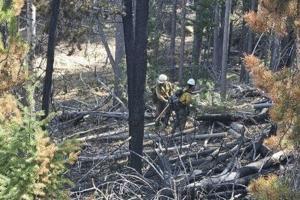It’s Easter weekend so those of you not going away, have four days in the garden. Let’s hope the weather is in our favour. We’ve certainly seen some warmer weather which has really brought plants on.
Looking good in my garden this weekend are several clumps of honey spurge or Euphorbia mellifera. This is a handsome, semi-evergreen shrub native to Madeira and the Canary Islands which has become a popular garden plant for its honey-scented summer flowers and an attractive domed growth habit and waxy leaves. The plant is also very popular with bees.

It can be grown in full sun or partial shade, and will vary in habit depending on the sunlight it receives. In full sun it will develop a denser, more compact shape and in shadier spots a looser and taller habit. It looks brilliant in my garden in growing both in exotic borders and gravel gardens.
It can be pruned back hard in spring if it starts to get too leggy, but remember to wear gloves when pruning, as the milky white sap can irritate the skin and eyes. Euphorbia mellifera has become a popular garden plant Next weekend there are two brand new gardens opening for the National Garden Scheme, both of which need to be pre-booked. The first is Duckyls in Selsfield Road, East Grinstead, opening both days, 26th and 27th from midday to 4pm with entry £8.
Pre-booking is essential, so please visit www.ngs.org.
uk and choose one of the two time slots at 12pm or 2pm. This recently renovated, 15-acre garden has wonderful views across Sussex and consists of a rhododendron woodland, a newly-planted orchard, ponds and a more formal secret garden and was mostly laid out in the 1920s and 30s by a dedicated plant collector and orchid breeder. Delight in the blazes of spring colour to be seen.
The second newcomer is Kotamki in Tottingworth Park, Broad Oak, near Heathfield, opening next Saturday 26th only from 10am to midday with entry £12 and children £6. Once again pre-booking is essential. The owners will provide a talk about the garden at 10.
30am. This is a large, creatively planted garden featuring a long double border within yew hedging, rockery, shade garden, exotic garden, pot garden, wildflower meadows and kitchen garden. There is an emphasis on continuity of interest via imaginative mixed plantings of shrubs, climbers, perennials, bulbs, annuals and self-sowers plus a varied collection of wisterias trained as shrubs, on trellis work, and on a pergola.
Pieris 'forest flame' has white flowers and new leaves appear bright red in spring Pieris japonica is an attractive evergreen shrub, grown for its handsome foliage and display of early spring flowers. The young leaves are often bronze or red, maturing to dark green. They contrast beautifully with the small, white jewel-like flowers, which are very attractive to bees.
Pieris is perfect for growing in a shrub border or woodland area, but it does require acid soil. If you don't have acid soil then choose a compact cultivar and grow it in a container of peat-free ericaceous soil. The one pictured in my garden is Pieris "forest flame" which has great foliage and white pieris flowers.
The new leaves appear bright red in spring, changing colour through pink, cream and green. Dyckia 'brittle star' is a bromeliad native to South America Dyckia "brittle star" is a wonderfully exotic bromeliad, native to Southern America, which is highly adapted to cope with the harsh realities of its surroundings. The foliage is beautifully serrated with silvery-white edges and a deep maroon-green centre, forming a starry rosette.
Dyckia are clump forming so you can expect offsets to eventually form at the base. I bought one last autumn and have kept it in the back porch until recently. As you may expect it is not super-hardy and is best grown in a container and placed in a full-sun to semi shaded position and placed outside during the warmer months.
Loropetalum chinense 'fire dance' deserves to be better known A new plant recently added to the garden is Loropetalum chinense "fire dance", which I’ve read is rarely seen in gardens. This handsome spreading shrub deserves to be much better known in my book. Its evergreen purple-bronze foliage provides fabulous year-round colour, and contrasts beautifully with the spidery, raspberry-red spring blooms, which are delicately scented and only adds to its charms.
This magnificent hardy shrub is ideal for sheltered borders and woodland gardens where it makes an eye-catching specimen in spring and provides a beautiful backdrop for colourful summer perennials. Mine are both planted in containers. I have been pleasantly surprised that many of the osteospermum I planted last year for summer colour, have made it through the winter and after cutting back, they have produced much new growth and will flower again this summer.
Also known as the Cape or African daisy, they are a great choice for long-lasting, colourful blooms through the summer and into autumn. Osteospermums also make great container plants. There are many colours to choose from and the vibrant daisy flowers are good for attracting pollinators.
Read more of Geoff’s garden at www.driftwoodbysea.co.
uk.
Health

Hoping for good weather so we have four days of Easter gardening!

It’s Easter weekend so those of you not going away, have four days in the garden. Let’s hope the weather is in our favour. We’ve certainly seen some warmer weather which has really brought plants on. Looking good in my garden this weekend are several clumps of honey spurge or Euphorbia mellifera. This is a handsome, semi-evergreen shrub native to Madeira and the Canary Islands which has become a popular garden plant for its honey-scented summer flowers and an attractive domed growth habit















